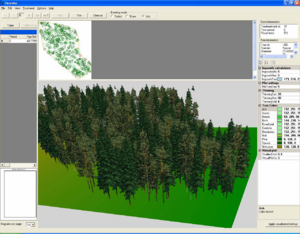|
|
| Line 24: |
Line 24: |
Warning: require(): Unable to allocate memory for pool. in /data/home/fp0804/www/wiki/includes/AutoLoader.php on line 1191
| | * is it a commercial product | | * is it a commercial product |
| | * does it have real-life application cases | | * does it have real-life application cases |
| − |
| |
| − | === Support for specific issues ===
| |
| − | Is the system designed to take into account specific uses? E.g. guidance on ways to characterize biodiversity, economic-biodiversity tradeoff analysis methods, risk assessment methods, landscape analysis methods, timber harvest effects, climate change effects, biological effects (pests, pathogens, invasives), fire,...
| |
| − |
| |
| − | === Support for specific thematic areas of a problem type ===
| |
| − | * Silvicultural
| |
| − | * Certification
| |
| − | * Conservation
| |
| − | * Restoration
| |
| − | * Transportation
| |
| − | * Development choices / land use zoning
| |
| − | * Policy/intervention alternatives
| |
| − | * Sustainability impact assessment (SIA)
| |
| − |
| |
| − | === Capability to support decision making phases ===
| |
| − | ''(NOTE I do not quite know what to do with this, as I do not understand it myself, although it seems related to system use)''
| |
| − |
| |
| − | (Click [[Simon's decision making model|here]] to see a more detailed explanation)
| |
| − | * Intelligence (+ explicit description of the support given by the DSS)
| |
| − | * Design (+ explicit description of the support given by the DSS)
| |
| − | * Choice (+ explicit description of the support given by the DSS)
| |
| − | * Monitor (+ explicit description of the support given by the DSS)
| |
| | | | |
| | === Related systems === | | === Related systems === |
| Line 52: |
Line 30: |
| | * the [[FMPP|Forest Management Planning Package]]. | | * the [[FMPP|Forest Management Planning Package]]. |
| | | | |
| − |
| |
| − | == Data and data models ==
| |
| − |
| |
| − | === Typical spatial extent of application ===
| |
| − | Define the scale of use for the application (user defined, regional, multi-owner forest single ownership forest, Multiple scale interaction)
| |
| − |
| |
| − | === Forest data input ===
| |
| − | This system combines field inventory and remote sensing data, allowing spatially explicit analysis with full coverage at high resolution.
| |
| − |
| |
| − | === Type of information input from user (via GUI) ===
| |
| − | Describe what is the information that the user directly inputs in the system if any): expert knowledge, opinion, goals and production objectives, preferences, stand/site information....
| |
| − |
| |
| − | == Models ==
| |
| − |
| |
| − | === Forest models ===
| |
| − | Growth, Yield, Carbon, Wood quality, biodiversity and habitat suitability, environmental and external effects (fire, storms, pests, diseases, climate change, etc)
| |
| − |
| |
| − | === Social models ===
| |
| − | historical and cultural values of sites, values due to peace and quiet, esthetic values, values due to recreational activities, ethical values): E. g. Recreation, Health, Game
| |
| − |
| |
| − |
| |
| − | == Decision Support ==
| |
| − |
| |
| − | === Definition of management interventions ===
| |
| − | Define what is available for the manager to intervene in the forest: time of harvest, plantations, thinnings, reconversions...
| |
| − | Existence of prescription writer, simple enumeration of all possibilities, scenario simulation , etc.
| |
| − |
| |
| − | === Typical temporal scale of application ===
| |
| − | Define the temporal scale of the application: E.g., operational and immediate level, Tactical planning (short term) and strategic level.
| |
| − |
| |
| − | === Types of decisions supported ===
| |
| − | *Management level
| |
| − | **strategic decisions
| |
| − | **administrative decisions
| |
| − | **operating control decisions
| |
| − | * Management function
| |
| − | * planning decisions
| |
| − | **organizing decisions
| |
| − | **command decisions
| |
| − | **control decisions
| |
| − | ** coordination decisions
| |
| − | *decision making situation
| |
| − | **unilateral
| |
| − | ** collegial
| |
| − | **Bargaining / participative decision making
| |
| − |
| |
| − | === Decision-making processes and models ===
| |
| − | *Logic modeling
| |
| − | *Operations research modeling
| |
| − | **Direct approaches
| |
| − | **Heuristic manipulation of simulation models
| |
| − | *Business modeling
| |
| − | *Simulation (with and without stochasticity)
| |
| − | *Multiple criteria/ranking
| |
| − | *Other
| |
| − |
| |
| − |
| |
| − | == Output ==
| |
| | [[Image:Heureka_visualization.png|thumb|300px]] | | [[Image:Heureka_visualization.png|thumb|300px]] |
| | | | |
| − | === Types of outputs ===
| |
| − |
| |
| − | Types of outputs produced (tables, maps, 3-D visualizations, pre-programmed summaries, etc)
| |
| − |
| |
| − | === Spatial analysis capabilities ===
| |
| − | * integrated capabilities
| |
| − | * facilitates links to GIS (wizards, etc.)
| |
| − | * provides standard data import/export formats
| |
| − | * allows spatial analysis (e.g. topology overlays (e.g. multi layering of different maps, selection of objects based on selection criteria, aggregation by attributes (e.g. areas of similar characteristics), Linking by logical means, Statistics by area, analysis with digital terrain model)
| |
| − |
| |
| − | === Abilities to address interdisciplinary, multi-scaled, and political issues ===
| |
| − | Evaluate interactions between different basic information types (biophysical, economic, social). Produce coordinated results for decision makers operating at different spatial scales facilitate social negotiation and learning
| |
| − |
| |
| − | == System ==
| |
| − |
| |
| − | === System requirements ===
| |
| − | * Operating Systems: (Windows, Macintosh, Linux/UNIX, Web-based, Others)
| |
| − | * Other software needed (GIS, MIP packages, etc...)
| |
| − | * Development status
| |
| − |
| |
| − | === Architecture and major DSS components ===
| |
| − | Describe the basic architecture of the system in software and hardware. Desktop client-server, web based, as well as the integration with available systems. Basic data flow, focusing on retrieval of required input and propagation and implementations of decisions. Mention its modular and scalability capabilities.
| |
| − |
| |
| − | === Usage ===
| |
| − | Describe the level of use: Research level use, Industry use, Government use
| |
| − |
| |
| − | === Computational limitations ===
| |
| − | Describe the system limitations: e.g. number of management units, number of vehicles, time horizon
| |
| − |
| |
| − | === User interface ===
| |
| − | Describe the quality of user interface and the Prerequisite knowledge for using the system
| |
| − |
| |
| − | === Documentation and support ===
| |
| − | Describe the connection to Help-system and possibilities for assistance, as well as the required training and user support levels
| |
| − |
| |
| − | === Installation ===
| |
| − | * Prerequisite knowledge: Level of effort to become functional
| |
| − | * Cost: (purchase price, development costs, demonstrated return on investment, cost of use, training costs, licence and maintenance costs)
| |
| − | * Demo: allows the download/utilization of a trial version. If yes, where is it available and what are the trial conditions.
| |
| | | | |
| | ==References== | | ==References== |
Heureka DSS is being developed within the Heureka research programme. It provides an analysis and planning set of tools for multi-purpose forestry and environmental protection.
Heureka consists of a set of decision support tools for forest resources analysis and planning. This DSS is still in development. It will provide utilities as timber and bio-fuel production, carbon sequestration, biodiversity, and recreation. It is divided into three different tools, depending on the potential users and problems:

